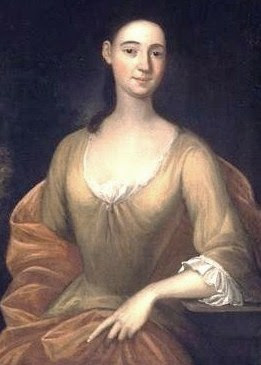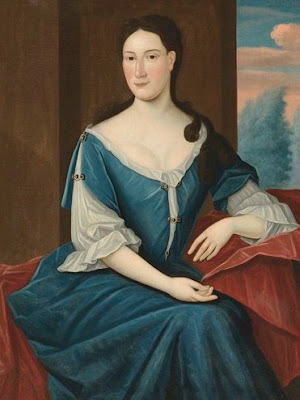. 1730-40 Artist: John Smibert 1688-1751. Subject: Sarah Middlecott 1678-1764 (Mrs. Louis Boucher). Henry Francis duPont Winterthur Museum. Mr. Louis Boucher, who had been born in France, was lost at sea in 1715. They had been married in 1702, in Boston by Cotton Mather.
1730-40 Artist: John Smibert 1688-1751. Subject: Sarah Middlecott 1678-1764 (Mrs. Louis Boucher). Henry Francis duPont Winterthur Museum. Mr. Louis Boucher, who had been born in France, was lost at sea in 1715. They had been married in 1702, in Boston by Cotton Mather.
 1735 Artist: Gansevoort Limner, possibly Pieter Vanderlyn 1687-1778. Subject: Miss Van Alen. National Gallery of Art.
1735 Artist: Gansevoort Limner, possibly Pieter Vanderlyn 1687-1778. Subject: Miss Van Alen. National Gallery of Art. Subject: Annis Boudinot Stockton (Mrs. Richard Stockton) 1715 - 1746 Artist: Attributed to Gerardus Duyckinck 1695 - ca. 1746. Princeton University Art Museum.
Subject: Annis Boudinot Stockton (Mrs. Richard Stockton) 1715 - 1746 Artist: Attributed to Gerardus Duyckinck 1695 - ca. 1746. Princeton University Art Museum.
I am interested in early 18th-century images of women in the British-American colonies who are wearing black or very darkly colored dresses, because they are relatively rare during this period. Did the dark clothing symbolize an event in the wearer's life or her situation? There are certainly more portraits by the end of the century, with several depicting older women in somber clothing. Is this mourning dress?
We know that by the 2nd quarter of the 18th century, colonists in British America were experiencing a full-blown consumer revolution. The gentry were building bigger houses & filling them with imported goods -- textiles, furniture, & tablewares. Colonists were displaying these new acquisitions to project an appearance of refinement & gentility akin to that in England. Women became more aware of fashion & their appearance.
In the middle of the 18th century, there was some concern about the loss of beauty as a woman grew older. Two poems published in the 1740s, warned young women, that they must develop their minds.
"The True Beauty" from American Magazine. September, 1744.
Tell me not of faces fair,
Coral lips, or jetty hair;
Rosy cheeks, and dimpled chin,
Fit to tempt a saint to sin;
Sparkling eyes, and snowy breasts;
Beauties by thy nymph possess.
Fairest faces will decay;
Jetty tresses soon turn grey;
Rosy cheeks must lose their dye;
Dimness seize the sparkling eye:
All that now is sweet, and fair,
Time will wrinkle and impair.
"To a Lady with a Withered Rose" from American Magazine. June 1745.
How transient is the fairest face! Soft beauty’s gayest charms
How vain! This rose, dear Cloe, lately shone
The brightest glory of the plain:
It blossom’d like the ruddy morn,
All pregnant with ethereal dew,
Diffus’d ambrosial sweets around,
And blush’d almost as bright as you.
Alas! How chang’d its damask pride!
Ah! Where is now that soft perfume?
That glow that swell’d the arched leaf,
The orient dye, the fragrant bloom?
All shrivel’d, faded, and decay’d,
Now drooping low its pallid head,
No longer grateful to the sense,
All its bright glories now are fled.
Tis thus, dear Cloe, thus thy charms,
Now shining like the new-born day
Each splendid blooming grace shall lose,
And like this wither’d rose decay.
That snowy skin, those killing eyes,
Must perish with the circling years;
Old age with hoary hairs comes on,
And every beauty disappears.
Learn then with charms to deck thy mind,
Those graces that can n’er decay,
Nor feel the wasteful hand of time,
The beauties of the mind alone,
Still verdant in eternal bloom,
No baneful change of Season know,
Nor with the frost of age consume.
But in immortal youth shall live,
When all that gay attracting form,
Which wond’ring mortals now admireShall nourish the devouring worm.
Nearly 50 years later, a similar essay aimed at older women trying to look and act like their younger counterparts, "Search After an Old Man" appeared in The Lady’s Magazine and Repository of Entertaining Knowledge published in Philadelphia, in 1792.
The time…is past when nature has attractions for love; and wisdom and discretion ought to supply the place of personal Beauty. They ought to be counsellors to the young, and not imitators of folly; they ought now to use that experience which they have acquired, to teach the young to avoid the errors into which themselves may have fallen, by an overweening attention to external ornament, and being more desirous to catch men, than to attract minds.
This view that women should be high-minded & virtuous heightened after the Revolution. In the new Republic, many believed that natural feminine virtues of humility & sensibility made women more religious & thereby, the perfect guardians for the nation's moral integrity.
It soon became expected that American women would instill traditional values in their children while protecting them in a refuge removed from the temptations of the outside world. American men would use their rational minds to make farms & businesses & government flourish. Little girls would be taught the domestic arts; little boys would be taught classical critical thinking.
Old women, who no longer had young children & could offer little help with household chores, were expected to be the ultimate repositories of these conservative feminine virtues & to convince daughters & grandaughters of their home-based usefulness to their new nation.
 1771-76 Henry Benbridge (1743-1812). Mrs Benjamin Simons. Metropolitan Museum of Art
1771-76 Henry Benbridge (1743-1812). Mrs Benjamin Simons. Metropolitan Museum of Art
1790 Ralph Earl (1751-1801). Mrs Nathaniel Taylor. Newark Museum. 1791 Ralph Earl (1751-1801). Mrs. John Watson. Munson-Williams-Proctor Institute of Art.
1791 Ralph Earl (1751-1801). Mrs. John Watson. Munson-Williams-Proctor Institute of Art.
 1792 Ralph Earl (1751-1801). Mrs. Richard Alsop. National Museum of American Art.
1792 Ralph Earl (1751-1801). Mrs. Richard Alsop. National Museum of American Art.
+New+Milford+Hist+Soc.jpg) 1796 Ralph Earl (1751-1801). Sarah Bostwick (Mrs. Sherman Boardman) New Milford Historical Society, Connecticut.
1796 Ralph Earl (1751-1801). Sarah Bostwick (Mrs. Sherman Boardman) New Milford Historical Society, Connecticut.
.+Anna+de+Peyster.+San+Antonio+Museum+of+Art..jpg)
1798 Charles Willson Peale (1741-1827). Anna de Peyster. San Antonio Museum of Art..
 1730 John Smibert (1688-1751). Possibly Hester Stanton Plaisted Gooch.
1730 John Smibert (1688-1751). Possibly Hester Stanton Plaisted Gooch. 1730 Gansevoort Limner possibly Pieter Vanderlyn. Susanna Truax.
1730 Gansevoort Limner possibly Pieter Vanderlyn. Susanna Truax.+Catarina+De+Wandelaer+Gansevoort+(1689-1767)+Albany+Institute+of+History+and+Art,+New+York.jpg) 1730 Pieter Vanderlyn (1687-1778). Catarina De Wandelaer Gansevoort (1689-1767.)
1730 Pieter Vanderlyn (1687-1778). Catarina De Wandelaer Gansevoort (1689-1767.)+Girl+of+the+Van+Rensselaer+Family..jpg) 1730 Pieter Vanderlyn (1687-1778) Girl of the Van Rensselaer Family.
1730 Pieter Vanderlyn (1687-1778) Girl of the Van Rensselaer Family. 1730-40s Unknown Artist Catalynje Post.
1730-40s Unknown Artist Catalynje Post. 1730s Gerardus Duyckinck (1695-1746.) Elizabeth van Braugh.
1730s Gerardus Duyckinck (1695-1746.) Elizabeth van Braugh..+Catherine+Williams+(Mrs.+Elias+Boudinot+III).+Princeton+Universtiy+Art+M.jpg) 1730s Gerardus Duyckinck (1695-1746 ). Catherine Williams (Mrs. Elias Boudinot III).
1730s Gerardus Duyckinck (1695-1746 ). Catherine Williams (Mrs. Elias Boudinot III). 1732 Pieter Vanderlyn (1687-1778). Young Lady with a Rose.
1732 Pieter Vanderlyn (1687-1778). Young Lady with a Rose. 1732 John Smibert (1688-1751). Hannah Gardiner (Mrs. James Mac Sparran.)
1732 John Smibert (1688-1751). Hannah Gardiner (Mrs. James Mac Sparran.) 1732 John Smibert (1688-1751). Jane Clark (Mrs. Ezekiel Lewis).
1732 John Smibert (1688-1751). Jane Clark (Mrs. Ezekiel Lewis). 1734 John Smibert (1688-1751). Judith Colman (Mrs. Thomas Bulfinch).
1734 John Smibert (1688-1751). Judith Colman (Mrs. Thomas Bulfinch). 1734 John Smibert (1688-1751). Hannah Pemberton (Mrs. Benjamin Coleman)
1734 John Smibert (1688-1751). Hannah Pemberton (Mrs. Benjamin Coleman) 1734 John Smibert (1688-1751). Mary Pemberton (1717-1763).
1734 John Smibert (1688-1751). Mary Pemberton (1717-1763).Crystal+Bridges+Museum+of+American+Art,+Bentonville,+Arkansas..jpg) 1735 Gerardus Duyckinck (1695-1746). Richa Franks.
1735 Gerardus Duyckinck (1695-1746). Richa Franks. 1735-45 John Smibert (1688-1751). Portrait of a Woman.
1735-45 John Smibert (1688-1751). Portrait of a Woman. 1735 Gerardus Duyckinck (1695-1746). Abigaill Levy Franks.
1735 Gerardus Duyckinck (1695-1746). Abigaill Levy Franks. 1737 Pieter Vanderlyn (1687-1778). Young Lady With a Fan.
1737 Pieter Vanderlyn (1687-1778). Young Lady With a Fan. 1739 Portrait of Deborah Glen.
1739 Portrait of Deborah Glen. 1739 Pieter Vanderlyn (1687-1778). Catherine Ogden.
1739 Pieter Vanderlyn (1687-1778). Catherine Ogden.





+New+Milford+Hist+Soc.jpg)
.+Anna+de+Peyster.+San+Antonio+Museum+of+Art..jpg)
.++Mrs+Richard+Brown+Smithsonian.jpg)
.++jean+Dick+(Mrs.+Anthony+Stewart)+MFA.jpg)
.++Millicent+Conway+Gordon++VA+Hist+Soc+Bridgemanartondemand.com.jpg)
.++Mrs+Matthew+Tiglman+Anna+Lloyd+%26+dau+Anna+Maria+1757+48+3.8+by+38+1.2+in.jpg)
.++Mrs.+William+Carmichael.+Art+Institute+of+Chicago..jpg)
.+Anna+Dorthea+Finney+1735-1817.+Biggs+Museum+of+American+Art+Dover,+Delaware..jpg)
.+Mrs+Middleton.+Hammond+Harwood+House,+Annapolis,+Maryland.jpg)
.++Elizabeth+Chew+Smith+LA+County+Mus+Art.jpg)
.+Rebecca+Holdsworth+and+grandaughter+Rebecca+Woodward.jpg)
.+Ann+Bond+Fell+Mrs+Edward+Fell+MHS.jpg)
.+Elizabeth+Galloway+(Mrs+Thomas+Sprigg).+Art+Institute+of+Chicago..jpg)
.+Mrs+Richard+Galloway+Met+artrenewal.com.jpg)
.+Margaret+Tilghman+Carroll+Mrs+Charles+Carroll+the+Barrister+MHS.jpg)
.+Sarah+Taliaferro+(Mrs.+William+Dainerfield)..jpg)
.+Susannah+Rose+(Mrs.+Gavin+Lawson).+Colonial+Williamsburg+Foundation..jpg)
.++Ann+Fitzhugh+Rose.+Colonial+Williamsburg+Foundation..jpg)



.+Wyntje+Lavinia+Van+Vechten.+Brooklyn+Museum..jpg)
+Catryna+Van+Rensselaur+Ten+Broeck.+Philadelphia+Museum+of+Art..jpg)
-oceansbridge.jpg)
+Maria+Van+Alen+(Mrs.+Thomas+Van+Alstyne.)+New+York+Historical+Society..jpg)
+Ariaantja+Coeymans+Verplank+(1672-1743)+Mrs+David+Verplank.+Albany+Institute+of+History+%26+Art..jpg)
+Elsje+Rutgers+(Mrs.+David+Schuyler,+Mrs.+Domine+Vas)+Albany+Institute+of+History+and+Art..jpg)


